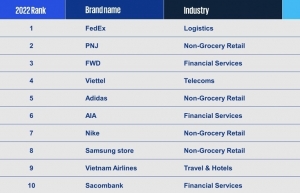The future of commercial banking
Commercial banking faces a more complex environment than ever before. Client demands, rapid enhancement in digital capabilities, and new sources of competition are forcing banks to urgently innovate. To respond quickly to market signals and to focus on the customer experience, commercial banks should embrace the concept of a connected enterprise approach that links the front, middle, and back offices to accelerate their journey to digital transformation.
THE TECH TRENDS IMPACTING COMMERCIAL BANKS
 |
| Nguyen Ngoc Hoang, director and digital innovation lead for KPMG in Vietnam |
Connected, AI-supported technologies can drive decision-making and prepare banks for cloud and API-enabled ecosystems. Both financial and non-financial players can thrive in new ecosystems open to integration, greater connectivity, and data sharing.
Technologies such as distributed ledgers and quantum computing will increase transaction efficiency and enhance information sharing, security, and transparency.
Adoption of cloud and API
Commercial banks are partnering with contemporary infrastructure providers to transform their legacy technology. Digitalised services, such as lending origination and onboarding, eliminate manual processes and legacy systems in favour of a single, end-to-end solution servicing small- and medium-sized enterprises, corporates, and commercial clients. Banks have invested significantly in automating their origination platforms as part of digital transformation.
API-enabled service architectures link existing bank data and client information to deliver enhanced services to customers. The use of APIs will enable new collaborations and partnerships across banks, digital banking companies and fintech companies. With reduced barriers to entry, new cloud-based lending services can be quickly operationalised.
AI and machine learning
These exciting technologies can help sales and marketing teams identify prospects and predict customer needs and propensity to buy. They also enable dynamic deal pricing for micro-segments, as well as automate decision-making processes, credit rule sets, and exceptions.
By adopting AI and machine learning, banks can accelerate the maturity of treasury functions and credit risk analysis. Most commercial banks are looking at these as the most important technologies to differentiate themselves from competitors in the commercial banking market.
Innovative tech to improve speed to market
The commercial banking market is witnessing the disintermediation by the disruptors who are innovating through technology-enabled solutions, for example, automated document population, e-verification, verifiable external data validation to simplify servicing assessments, financial spreading, and deal structuring, which rapidly reduces the time to make a credit decision.
Distributed ledger tech
The current market is volatile and is witnessing a shift from the centralised model to the decentralised model along with distributed ledger technologies, which will bring increased transaction efficiency, inclusion, transparency, and digitalisation of assets. Blockchain-based trade finance networks already help commercial banks, and their customers eliminate operational friction and reduce fraud and compliance risk.
There are increasing numbers of syndicated lending pilot projects, products, and services, while the key elements of commercial banking – collaboration, competition, and distributed customers – are ripe for distributed ledger solutions. Banks operating across borders are at an inflection point, where they should consider the tokenisation of Nostro and Vostro accounts, programmable payments for trade and smart contracts.
Leveraging data to create value
Niche solutions can be incorporated into a data ecosystem where competitors can be collaborators. Leading commercial banks are changing their role to become both producers and consumers of data by selling payments, trade finance, and lending capabilities to other organisations.
The huge volumes of data generated should help commercial banks deepen their relationships with clients, by personalising digital experiences and communicating highly personalised and timely messages, based upon intimate customer knowledge.
A digitally capable workforce
A digital business model, which harnesses advanced data and analytics and digital channels to offer self-service, should have significantly lower costs and better customer service.
Person-to-person relationships are expected to continue with relationship managers (RMs) being deployed in a more targeted manner: to profitable clients; in situations where extensive personal care and attention is a unique selling point; when clients need industry or sector expertise that technology cannot deliver; and for complex, escalated service enquiries that cannot be resolved digitally.
Data is improving RMs’ roles, offering deep client and sector understanding of emerging trends, business and financial risks, and growth opportunities, and how these affect the bank’s portfolio of services and products. For example, data enables peer comparisons and provides early indicators of client attrition, enabling fast action to help improve retention.
ANTICIPATED BUSINESS MODELS FOR COMMERCIAL BANKS
By understanding the technology trends and the new commercial banking ecosystems, the banks can explore likely future business models. The banks are becoming platforms, providing an evolving mix of business products and services, and integrating vertically and horizontally across the value chain.
These models are agile, scalable, and will be open to other service providers and their clients. They provide a relevant, digital-first, customer-centric proposition through cloud platforms.
As commercial banks contemplate this changing environment, they should consider and decide which clients need to own and maintain relationships, if and how certain services are outsourced, and whether to build the digital banking product as a ’super app’ or a ’service in a wallet’.
Reimagined digital commercial bank
These banks will transform into fully connected digital banks, leveraging capital and data while commercialising traditional cost centres through the re-bundling of services. They will offer a full range of hybrid value propositions and banking services to generate new income streams.
They will focus on intricate and substantial private equity financing, leveraging human relationships and complex case expertise, including advisory functions for clients that require the banks’ specialist knowledge.
In addition, they will leverage data-driven insights, including those at the industry and individual client levels. They convert sector insights into thought leadership publications and can commercialise those insights.
Banking-as-a-Service
Banking-as-a-Service providers will develop and license services and products and manage user interfaces to provide commercial banking services to end users, through intermediary partners.
They will rely on products and services for income streams and deliver through APIs using a platform-based infrastructure. Examples include payment management solutions, risk scoring products, Know Your Customer verification services, risk profiles, and financial crime screening to reduce the verification and onboarding of customers to under 48 hours.
In addition, banks could start packaging new financial products and offer smart contracts in digital currencies and software IP licensing.
Platform provider
The platform provider develops infrastructure to enable the commercial banking ecosystem by providing, maintaining, or policing a banking platform or ecosystem with either open or closed access, for its own and others’ purposes. The platform is a gateway to any number of services and clients, and the technological infrastructure is a key source of income.
Applications include the development of digital product marketplaces, ‘mega apps’, cloud services and API governance, and the management of third-party data connections. As a result, there will be capital market disintermediation, new data, and information trusts.
IMPERATIVES FOR BANKS TO TRANSFORM THEIR BUSINESS
Historically, success has relied on RMs to acquire, nurture, and retain client relationships while selling a broad range of the bank’s products and services. Relationship management models will be complemented and, where appropriate, superseded by digital. Transactional and routine tasks will be executed digitally, enhanced by robotic advice and chatbots.
This will free up RMs’ capacity to become a banking solution architect, financial risk advisor, and driver of trust for clients, using data insights to inform meaningful, personalised, relevant, and timely interactions.
Transition to new ecosystems
New ecosystems will be accessed via open platforms, facilitating new partnerships encompassing a range of services across banking and beyond. Such an approach combines legacy banks’ risk and compliance capabilities with leading-edge technologies and new customers. Through horizontal integration, banks can develop solutions that can be applied across multiple verticals (such as customer segment or industry) with minimal modification.
Assess current tech systems
Commercial banks should evaluate whether their current technology platforms and architecture are fit-for-purpose, and decide if they should adapt, hollow out, create a digital skin or twin, or replace and re-platform current systems to better align to the future.
Transform operating model
To thrive in digital transformation, commercial banks should aim to optimise cost structure by transforming the operating model. To deliver better returns on capital, the banks can focus on the performance indicators such as reducing costs-to-income, measuring capital effectiveness, and then optimising capital allocation.
Deliver excellent services via AI
Through automated and AI-enabled digital operational processes, banks can improve the speed and quality of decision-making and enhance customer experience. However, banking leaders and teams will need to act as a moral compass to embed ethics, regulations, and security into technological innovation.
(The views and opinions expressed herein are those of the author and do not necessarily represent the views and opinions of KPMG in Vietnam.)
 | KPMG launches 2022 Vietnam Customer Experience Excellence Report A new KPMG report identifies the leading performing brands and industries providing exceptional experiences from the consumer's point of view. |
What the stars mean:
★ Poor ★ ★ Promising ★★★ Good ★★★★ Very good ★★★★★ Exceptional
Related Contents
Latest News
More News
- From easy money to selective bets: investment prospects for Vietnam in 2026 (January 06, 2026 | 16:51)
- Stock market starts 2026 with growth and governance in focus (January 06, 2026 | 08:45)
- Cake by VPBank posts strong gains in scale and efficiency leveraging AI focus (January 05, 2026 | 18:55)
- Banks step up listing plans in 2026 to strengthen capital and transparency (December 31, 2025 | 18:59)
- Ho Chi Minh City projects $10.5 billion remittance inflows in 2025 (December 31, 2025 | 18:58)
- New decree sharpens enforcement in securities market (December 31, 2025 | 18:53)
- Gold market reform advances as SBV receives applications for bullion production (December 30, 2025 | 12:07)
- EVN and AFD sign credit agreement for Vietnam’s first pumped storage hydropower plant (December 30, 2025 | 10:06)
- Techcombank Priority Visa Signature unlocks a higher standard of living (December 29, 2025 | 16:44)
- Tax sector wraps up 2025 and sets priorities for next year (December 25, 2025 | 14:00)

 Tag:
Tag:



















 Mobile Version
Mobile Version